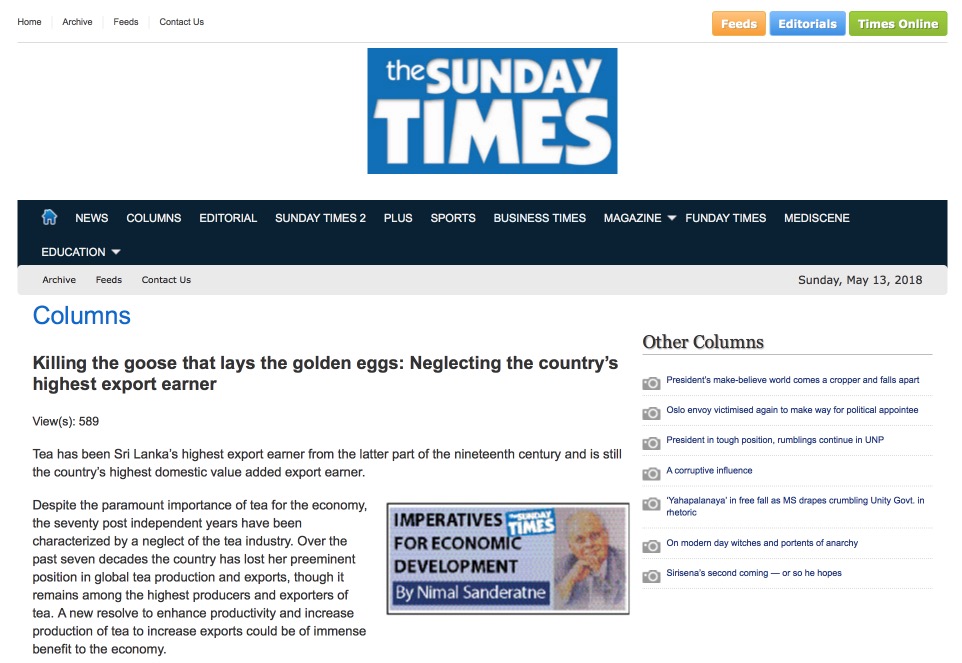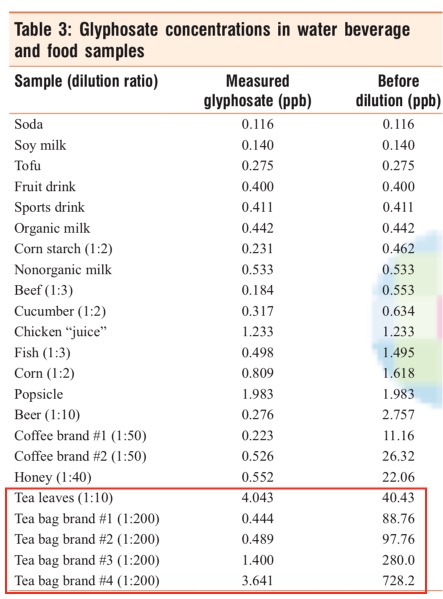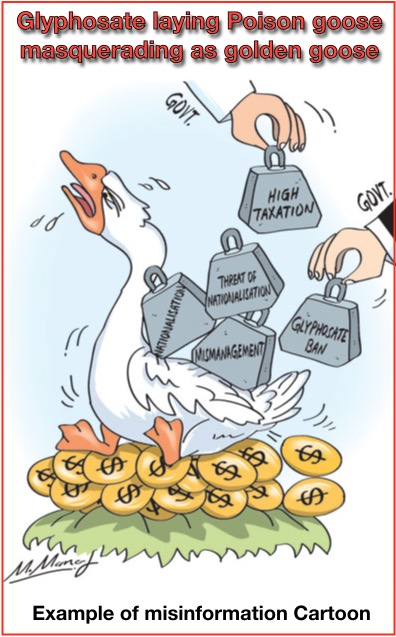Glyphosate in Tea, and the effect on the tea drinking population.
++++++++++++++++++++++++++++++++++++++++++++++
I had seen the evidence, from CFIA tests in Canada, that North America produced the most toxic of all seed based foods on the planet, from wheat to rye, barley, oats, to beans, chickpea and lentils.
I also knew that people were getting poisoned far faster and with a far greater dose of glyphosate from non-GMO crops than GMO, which in general contained far less amount of glyphosate, with rice and quinoa being the only known exceptions.
I had seen further evidence that processed foods were on average lot more toxic with glyphosate than the same food in raw stage before processing. Such as carrots from the field (much cleaner), compared to carrots coming from famous branded tinned variety (dirtier with glyphosate contamination). Besides, most of the popular food processors including baby food and morning cereal makers somehow appeared to add a lot of glyphosate into their products, such as Kelloggs. I even wrote a letter to them about it, but only got a sort of holding message without follow up.
I had not paid too much to beverages, since not much of that was tested, and because it was so hard to guess what ingredients were included in popular health drinks etc.
However, coming to India, a major tea growing and tea drinking nation with high population, I became increasingly conscious of the issue of glyphosate in tea production. Tea garden owners have told me they have been using glyphosate in tea gardens for a long time, perhaps stretching a generation.
I have found that in rubber plantations, even in remote Himalayan foothills, glyphosate has reached.
Then Sri Lanka imposed a nationwide ban of glyphosate due to suspicion that it was killing farm workers from Kidney failure. Recently commercial pressure has pushed Sri Lanka to selectively open up Glyphosate in tea and rubber production.
So, when I heard about research papers from the US that seemed to find higher concentration of glyphosate tea compared to lots of processed foods and beverages, I found the authors of the study, but could not lay my hands on the published paper.
So I asked around and am thankful for agro-scientist André Comeau of Quebec, Canada, for sending me the link to the paper, which I have now downloaded and given it a cursory look, saving it for thorough reading in a few days. Apparently, a lot more glyphosate is noted in people’s urine that have drunk tea in the last 24 hours. I know glyphosate does bioaccumulates, so what is seen in the Urine is only a fraction of the stuff that one drinks. The rest goes into the person’s biology – one way or another, and ends up in all kinds of places it should not be – thus starting a long process of diseases or ill-health.
This chart is from that paper.
I used to think a billion plus people of India are getting mass scale poisoned primarily from imported daal (pulses) from countries such as Canada, Australia etc.
But now that I know how glyphosate has penetrated every aspect of modern farmlands growing virtually anything, from potato to cauliflower to rice, and how it is so visible in processed tea bags, I am beginning to suspect the billion strong population might be poisoned both from imported pulses, as as well most anything homegrown, from food to tea.
I feel increasingly sure the the tea-glyphosate link is not unique to India but across the entire tea producing world, from China to Africa, but we shall not know till someone starts broad based testing all these tea leaves, tea dust and tea bags.
It appears that the people in India, while being focussed on resisting GMO, might have allowed a thousand fold bigger tide of poison through reckless, and unchecked use of glyphosate everywhere on one side, and absolute absence of either any testing to see if any of that is safe, and same time without any test of how much of it is in the average diet of people here.
It looks like an unimaginable tsunami of ill-health is bearing down on India and all tea drinking regions, and I can already see the tell tale signs of it, with a cursory look at my friends and relatives and noticing the inexplicable rise of auto-immune diseases that were virtually unheard of a decade ago.
To make matters worse, the paper itself does not specifically say if the test also included presence of AMPA, the first metabolite of glyphosate. It is possible that the test excludes AMPA, in which case the actual toxicity from glyphosate/AMPA might be much higher than the figures shown. In absence of a clear mention, I am inclined to believe the data only contains glyphosate.
This should go into my blog – its too important and worrisome to ignore.
MEDIA MISINFORMATION
Then there is the issue of fake news, wrong news, yellow journalism, and news that are designed to give one sided information on safety of glyphosate, in this case in tea.

http://www.sundaytimes.lk/180513/columns/killing-the-goose-that-lays-the-golden-eggs-neglecting-the-countrys-highest-export-earner-293827.html
The above news article, from The Sunday Times from Sri Lanka is a good example of bad reporting, and misleads the reader. On the surface of it, it essentially states what might be correct and obvious – that export of tea is a golden goose of Sri Lankan exports.
It further, take great pains to state that banning glyphosate on assumption of physical harm (death from kidney failure) is scientifically baseless. The actual sentence is “The latest blunder was the banning of glyphosate imports that is an essential weedicide in 2015 without a scientific basis“.
What the article fails to indicate, that proof that glyphosate in any food or drink is actually safe, has not been released by any government, and that non-release of such safety data makes approval of glyphosate to be illegal, and any claims that it is safe – little better than baloney.
The industry, that appears to have influenced every government on earth starting from USA, and prevented all of them from disclosing safety test report and raw data to the public, is careful is providing a plethora of scientific reports, all carefully picked, that indicate glyphosate was found not to cause any harm to animals. All these tests are, in fact, third party opinions and little else.
What actually constitutes proof of safety, is a comparison in health parameters of one group of test animals fed food with a measured dose of glyphosate, and health parameters of an identical batch of animals living an identical lifestyle and eating identical foods, without without any glyphosate. This comparison either proves glyphosate does not cause any harm to the animals or shows evidence of harm. This and this alone constitutes proof of safety. And this document, usually going into tens of thousands of pages of data on tests conducted usually on more than one group of animals, usually mammals, has been submitted to most governments in order to have them approve glyphosate for use in agriculture. And this is the document that has been kept out of public eye, which makes the approval illegal in my understanding of the law.
If a government cannot disclose safety test report and data of a toxin or non-food item to be used in agriculture, then the government may not approve nor release that item for use in agriculture either. That is how I understand constitutional law in most countries that are democratic and supported by a constitution.
The report should mention that Sri Lankan people have seen no proof whatsoever that presence of glyphosate in their food or beverage does not hurt the consumer. Also, Sri Lanka has not conducted any test of directly exposing glyphosate to test animals, like their sugarcane workers and tea garden workers have been exposed to glyphosate, to see if there is any adverse health impact on the animals.
The report also failed to disclose that sugarcane workers were dying of kidney failure only after the practice of spraying glyphosate on sugarcane was started, and some tea garden workers started developing throat cancer, suspected from exposure to glyphosate.
It is not very difficult to conduct tests on lab animals to see if comparative exposure to glyphosate duplicates these maladies on animals or not.
The paper has been harping on the golden goose of export dollars, but by failing to mention the health risks and the total absence of proof of any safety, implies that earning export dollars is worth more than deaths and illnesses of Sri Lankan Farm Workers.
That, to me is worse than yellow journalism. An honest journalist would not pen such a blatantly one sided article, but a poison peddler might.


